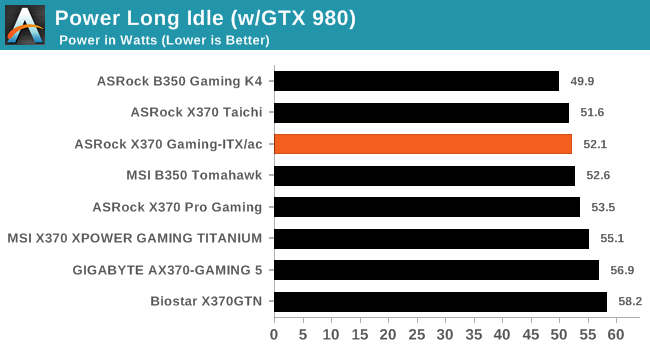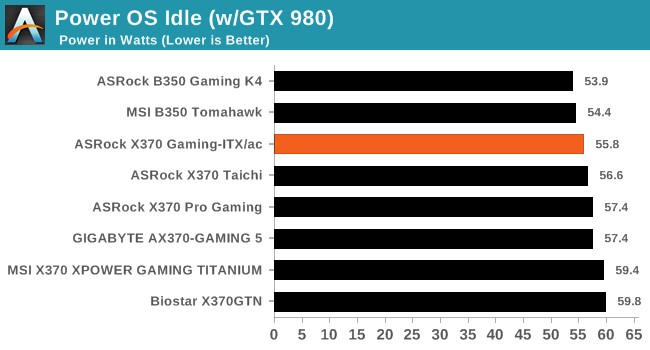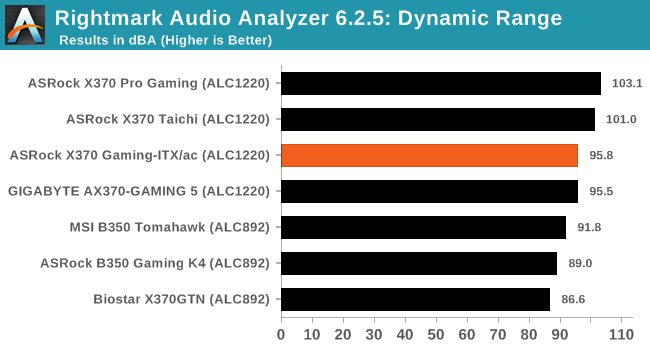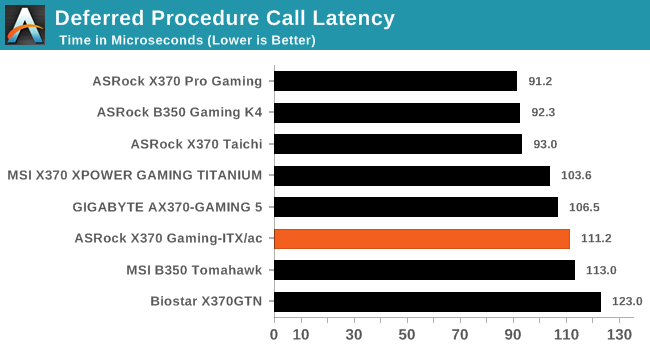The ASRock X370 Gaming-ITX/ac Motherboard Review
by Gavin Bonshor on April 18, 2018 8:00 AM EST- Posted in
- Motherboards
- Gaming
- AMD
- ASRock
- Mini ITX
- ITX
- AM4
- Ryzen
- X370
- X370 Gaming-ITX/ac
System Performance
Not all motherboards are created equal. On the face of it, they should all perform the same and differ only in the functionality they provide - however, this is not the case. The obvious pointers are power consumption, but also the ability for the manufacturer to optimize USB speed, audio quality (based on audio codec), POST time and latency. This can come down to manufacturing process and prowess, so these are tested.
Power Consumption
Power consumption was tested on the system while in a single ASUS GTX 980 GPU configuration with a wall meter connected to the Thermaltake 1200W power supply. This power supply has ~75% efficiency > 50W, and 90%+ efficiency at 250W, suitable for both idle and multi-GPU loading. This method of power reading allows us to compare the power management of the UEFI and the board to supply components with power under load, and includes typical PSU losses due to efficiency. These are the real world values that consumers may expect from a typical system (minus the monitor) using this motherboard.
While this method for power measurement may not be ideal, and you feel these numbers are not representative due to the high wattage power supply being used (we use the same PSU to remain consistent over a series of reviews, and the fact that some boards on our test bed get tested with three or four high powered GPUs), the important point to take away is the relationship between the numbers. These boards are all under the same conditions, and thus the differences between them should be easy to spot.



From the current trend within our B350/X370 power testing, ASRock boards (with the exclusion of the X370 Pro Gaming) have tended to perform pretty well against other boards on test. The X370 Gaming-ITX/ac shows respectable performance at both idle and long idle power states, with another good showing while at full load.
Non-UEFI POST Time
Different motherboards have different POST sequences before an operating system is initialized. A lot of this is dependent on the board itself, and POST boot time is determined by the controllers on board (and the sequence of how those extras are organized). As part of our testing, we look at the POST Boot Time using a stopwatch. This is the time from pressing the ON button on the computer to when Windows starts loading. (We discount Windows loading as it is highly variable given Windows specific features.)

In a twist to our testing, the ASRock X370 Gaming-ITX/ac seems to boot considerably faster than the rest of the pack when the UEFI BIOS defaults are enabled. In our stripped POST time metric, the time was improved upon by around half a second.
Rightmark Audio Analyzer 6.2.5
Rightmark:AA indicates how well the sound system is built and isolated from electrical interference (either internally or externally). For this test we connect the Line Out to the Line In using a short six inch 3.5mm to 3.5mm high-quality jack, turn the OS speaker volume to 100%, and run the Rightmark default test suite at 192 kHz, 24-bit. The OS is tuned to 192 kHz/24-bit input and output, and the Line-In volume is adjusted until we have the best RMAA value in the mini-pretest. We look specifically at the Dynamic Range of the audio codec used on the rear panel of the board.

All of the boards equipped with Realtek ALC1220 codecs perform a little bit better than the cheaper ALC892 alternatives. While the ASRock X370 Gaming-ITX/ac does include PCB separation, and with ITX boards usually being hit with a slight penalty, it doesn't appear to be the case with this particular model.
DPC Latency
Deferred Procedure Call latency is a way in which Windows handles interrupt servicing. In order to wait for a processor to acknowledge the request, the system will queue all interrupt requests by priority. Critical interrupts will be handled as soon as possible, whereas lesser priority requests such as audio will be further down the line. If the audio device requires data, it will have to wait until the request is processed before the buffer is filled.
If the device drivers of higher priority components in a system are poorly implemented, this can cause delays in request scheduling and process time. This can lead to an empty audio buffer and characteristic audible pauses, pops and clicks. The DPC latency checker measures how much time is taken processing DPCs from driver invocation. The lower the value will result in better audio transfer at smaller buffer sizes. Results are measured in microseconds.

None of the manufacturers boards that have been on test so far have been optimized for DPC latency. The ASRock boards have generally done well in regards to DPC latency compared to other manufacturers like MSI and GIGABYTE, but the X370 Gaming-ITX/ac does fall a little short of its bigger M-ATX and ATX siblings that have been tested so far.










30 Comments
View All Comments
1_rick - Wednesday, April 18, 2018 - link
On the antenna? Yeah, I made a mistake on my previous post: the antenna wire pulled right out of the plug. Looks like it was only inserted or crimped in by pressure; no solder: the end of the wire is clean and not ragged. I tried pushing it back in but it didn't make a good enough connection; I never good good signal after that. (Oddly, even with both leads plugged in it got poor reception.)I'm using one of these now: https://www.frys.com/product/7411565. Keep meaning to buy a second, but the machine runs OK with just one.
Not sure what's going on with the ethernet port, if it died or if I killed it, although I don't know what I could've done to it. If the wifi didn't work I'd be more concerned.
My board couldn't run RAM at over 2133-2400 stably until the most recent BIOS updates; now it runs my 3000 ram at 2933 just fine.
Also these comments inspired me to try OC a bit more--currently I'm running at 4.0 with 1.39375. Games fine; haven't tried a stress test yet.
The_Assimilator - Thursday, April 19, 2018 - link
This board exposes 2x 480Mbps (USB 2.0), 2x 5Gbps (USB 3.1/3.1 gen 1), and 2x 10Gbps (USB 3.1 gen 2) USB ports on its IO. The X370GTN exposes 4x 5Gbps and 2x 10Gbps ports.jtd871 - Monday, April 30, 2018 - link
Check your eyes, sir. Neither this board nor the B350 version claim Gen 2 support. http://www.asrock.com/mb/AMD/Fatal1ty%20X370%20Gam... http://www.asrock.com/mb/AMD/Fatal1ty%20AB350%20Ga...Hifihedgehog - Wednesday, April 18, 2018 - link
Gavin, despite what manufacturers may say, HDMI 2.0 works on all 300-series motherboards as well. I thoroughly investigated and tested this with Raven Ridge. In fact, my family's current HTPC, with a Ryzen 5 2400G and ASRock AB350 Gaming-ITX/ac, works flawlessly at 4K@60Hz and 12-bit color. The so-called "specification" these motherboard manufacturers list is really regarding certification alone. The ports really are just straight traces to the processor's video outputs. See here for more details:smallformfactor (dot) net/forum/threads/raven-ridge-hdmi-2-0-compatibility-1st-gen-am4-motherboard-test-request-megathread.6709/
John_M - Saturday, April 28, 2018 - link
I couldn't see the point of paying extra for the X370 version of this ITX board when the B350 delivers exactly the same performance and functionality so I bought the latter. Apart from the chipset used the only difference I can find is the different WiFi card. Does anyone disagree?jtd871 - Monday, April 30, 2018 - link
That appears to be one of very few differences that I can spot between the official specs for each board. The X370 claims 2T/ 2R on the wifi. The other difference that I noticed was a claimed difference in watercooling support (see CPU section on the respective spec page of each board via AsRock.com). I second your recommendation to get the B350 board as it is significantly less expensive as of this post.John_M - Saturday, April 28, 2018 - link
What do you mean when you use the term "ambient cooling"? I Googled it and found that it refers to the building of datacentres in locations that are naturally cool so as to save costs on cooling. But what does it mean in the conetxt of this review?John_M - Saturday, April 28, 2018 - link
There are five 3.5mm audio jacks, not six.John_M - Saturday, April 28, 2018 - link
You can overclock the iGPU of a Raven Ridge APU in the BIOS, though it's hidden quite deep in the menus of the Advanced page.wswab - Wednesday, February 13, 2019 - link
HOW DO YOU SET THE (IT WAS ERP READY IN MY GIGABYTE BOARD ) OR WHERE IS SETTING TO STOP USB PORTS FROM STAYING POWERED ON AFTER SHUTDOWN !! LED,S STAY LIT !! HELP APPRECIATED ..